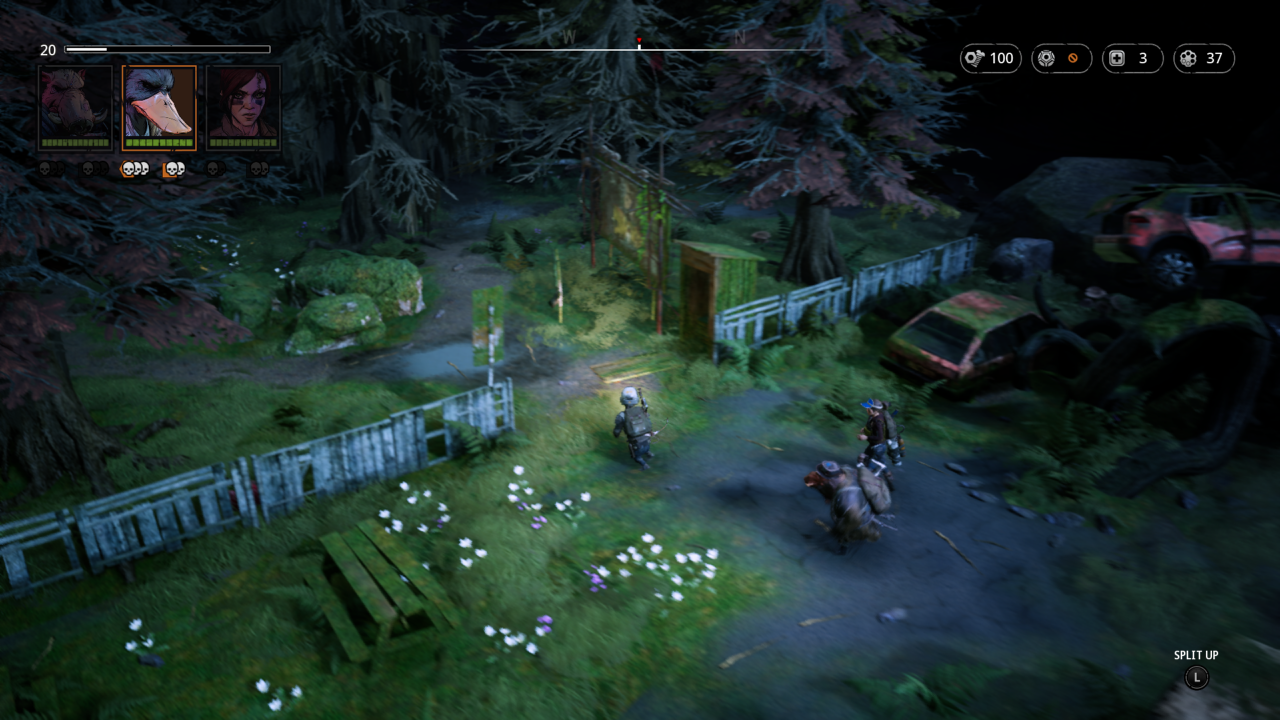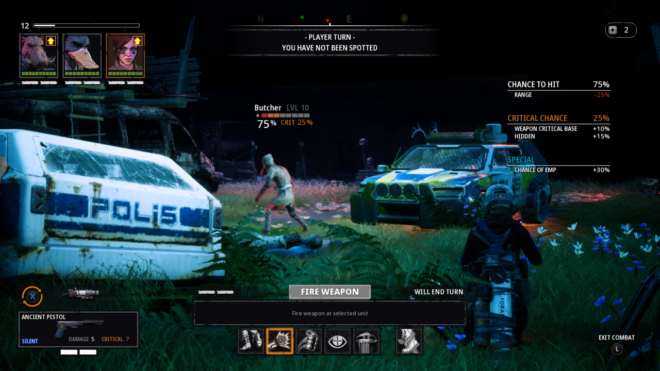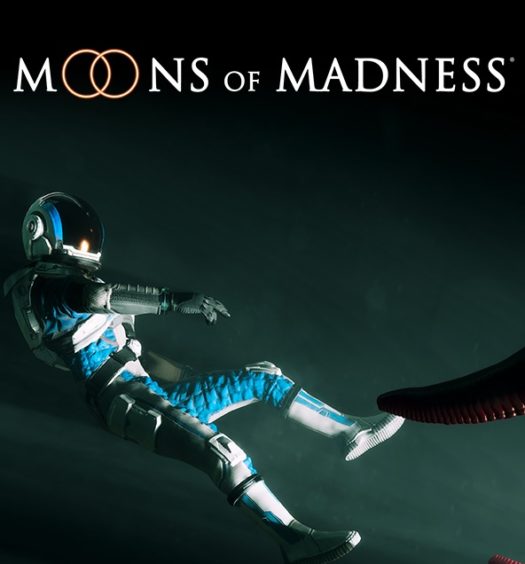The only thing you need to know about Mutant Year Zero: Road to Eden is that you can play as a duck. A grizzled, gun-toting, anthropomorphic duck. The design is spot-on, realistic without being creepy, rough-and-tumble, while still looking dashing in just about any hat you can find. He’d be the perfect character if it weren’t for one small but glaring flaw: his name is Dux. A pun that bad should be labeled a biohazard; if you experienced any physical or emotional discomfort after reading that name, please consult a doctor immediately. Hearing it in dialogue is never not cringe-inducing, but let’s not let a moniker tarnish the majesty that is the dapper top-hat mallard-man. There’s plenty more to cover about this game, but don’t expect any of it to be named well.
Here’s what I liked:
Duck to a gun fight – If you’re familiar with XCOM and other similar turn-based strategy games, then you basically understand the combat in Mutant Year Zero. Move your units on a square-based grid, make decisions based on various stats and likelihood percentages, attack enemies in range, then wait for the enemy to do the same. Rinse and repeat until one team is killed. Mutant Year Zero doesn’t do much to shake up the formula, but its rendition is undeniably solid. There are five playable characters (called Stalkers), but only three can be placed in your active party. They’re all mutant hybrids pulled from wildly different gene pools, each with unique powers unlocked as they level up. Dux can eventually sprout moth wings for flight, boar-man Bormin can charge enemies through walls and nature-infused Selma can trap enemies with tree roots. These powers are fun, but the majority of combat is done with standard weaponry. Here every character is basically the same, as loot is interchangeable between everyone. Each Stalker has a load-out of two weapons, two grenades and two armor slots that can be altered outside of battle. This wide variety of customization makes every character distinct while being mailable enough to make a squad distinctly yours.
Mutant Gear Solid – What really makes the combat stand out isn’t the actual skirmishes; it’s how you get ready for them. Outside of combat you get free control of your squad, letting you explore the post-apocalyptic world as you please. There’s plenty of currency and other prizes that make going off the beaten path worth your while, but sooner or later you’re going to come across a group of ghouls. In comes the game’s biggest strength: stealth. Crouching lets you sneak past enemies, giving you incredible control in how you approach combat. You can spend this pre-battle time strategically placing your units, surrounding the enemy to jump out at the most opportune moment. Combat is initiated in one of two ways; either you start the ambush and attack first, or the enemy spots you and shoots on sight. Either way, you’re locked into a grid, and turn-based combat begins. Combat ends when all aware enemies are dead – meaning if an enemy gets separated from the pack, you have the chance to quietly take them out without committing to fighting the whole army.
Here’s what I didn’t like:
Thick skin – Despite permadeath being optional, this is a challenging game even on the lowest difficulty. Enemies may be the same level as you, but they have larger health bars, better armor, and a larger crew. This drives home the importance of stealth, but also just how bad things can get if you fail. Weapons aren’t amazingly powerful, often taking a whole team’s firepower to take out a standard grunt. If you’re attempting a sneaky assassination but miss a shot, then the lucky survivor using his turn to alert everyone else. Shootouts are very tactical, but also slow. With only two action points per character, only one of which can be an attack, battles take time and patience. When guns need to be reloaded, and teammates revived, entire turns can go by without having an action to spare on fighting back. Nothing I’ve pointed out so far I’d say is outright bad, and there’s undoubtedly those that would count this as a plus, but personally, it frustrated me to no end. Starting over a lost battle to literally approach it from a different angle keeps those second attempts interesting, but when those failed attempts take a half hour or more losing feels like a huge waste of time. You feel under-leveled even when you’re not, largely due to an economy that makes upgrading weapons (damage output) a lot slower a process than leveling up characters (health and skills).
In a world… – While the gameplay is solid across the board, there’s a noticeable unevenness across various aspects of the presentation. Based off a table game, the backstory of this world is incredibly rich and interesting, but our protagonists’ main adventure is fairly by-the-numbers. The game still manages to be compelling because your squad is made of actual characters with personalities, constantly conversing through their travels. The voice acting for the leads is done very well, but the same can’t be said for the entire cast. Supporting roles are very hit or miss, with some performances sounding very forced and unnatural. Visually the game is impressive, sometimes to its detriment. During combat cursor actions can get lost in the battlefield, and it can be hard to spot enemies if not for their giant health bars. Cramped buildings can be a headache as the game’s removal of visual obstructions makes knowing your surroundings difficult, especially because it leaves behind the action highlighting for the floor above and below you for added obfuscation.
Make your move – Playing on an original Xbox One, the game struggles during combat sections. The worst offender is the dynamic destruction, an undeniably interesting addition that makes the performance fall off a cliff. Having completely destructible environments present some fun strategies, my favorite being blowing the floor out from under unsuspecting ghouls, but breaking even a small fence makes the frame rate tank. Most of the bugs are a lot more inconsequential, like characters getting stuck in animations or refusing to do animations, but annoyingly frequent. The easiest way to spot enemy units is the giant status bar over their heads, but they all too often become anchored to the wrong location or disappear entirely. The enemy turn doesn’t fare much better, often being the worse hit to performance. You have the option to fast-forward through the enemy’s turn, but it becomes an illegible stuttering mess that stops and starts between each action. Fast forwarding rarely feels like the faster option; it’s as if the AI still needs time to decide what moves it’s going to make.
Wrap-up:
Mutant Year Zero: Road to Eden is a clever take on the turn-based RPG, blending it with freeform exploration in a way that feels natural and satisfying. It’s unfortunate that the rest of the game can’t match the well-realized concept, giving off the sense of a great execution that wasn’t fully baked. For the genre, it’s a surprisingly bite-size experience that, while may not be the most friendly to newcomers, fans should definitely check out.
Score: Reader’s Choice
Mutant Year Zero: Return to Eden was developed by The Bearded Ladies and published by Funcom. It was released December 4, 2018, for $34.99. A copy was provided for review purposes.






